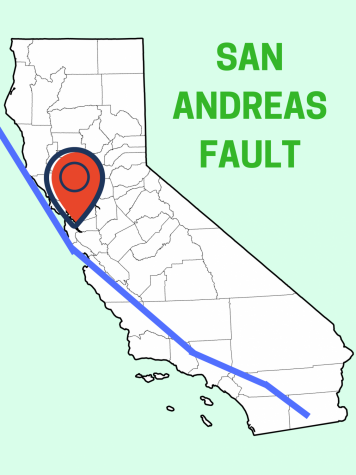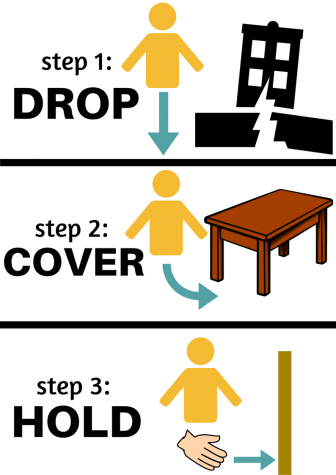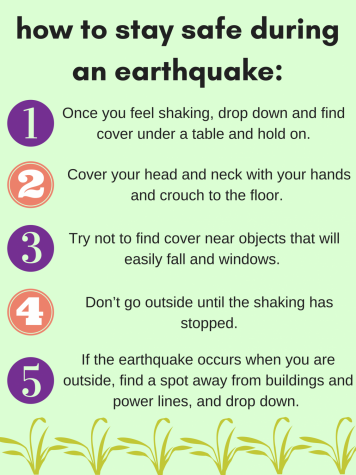Is a massive earthquake coming to California?
January 16, 2018
The familiar yet alarming sense of the ground shaking instills in me a sense of panic and fright. I immediately search my surroundings and find cover underneath my desk, hiding there until the shaking finally ceases.
According to the United States Geological Survey, just southern California experiences around 10,000 earthquakes a year. For years, seismologists have been discussing the ‘The Big One,’ a massive quake that has been long overdue in the state. The last major earthquake in California took place in 1857 with a magnitude of 7.9, which created a series of aftershocks that lasted for 3.5 years.
“The average time between these quakes is about 100-150 years. In some cases, the time separation between quakes is as short as 60 years, and in others it is around 300 years,” Robert Graves, a research geophysicist at the USGS, told Newsweek. “This variability is one reason that makes forecasting when the next quake will occur quite difficult. But, it will happen sometime.”
The San Andreas fault is 800 miles long and runs through the western border of California. It forms the tectonic boundary between the Pacific Plate and the North American Plate. According to seismologists, the Pacific Plate and the North American Plate are sliding past each other, which is causing movement in the San Andreas Fault. This is said to be the cause of the several recent tremors and quakes throughout the state.
“If the plates do slip and it does pop, there’ll be bigger quakes,” Upper school environmental science teacher Jeff Sutton said. As long as there’s little ones as they keep sliding past, then that relieves the pressure between the two plates and helps reduce the chance that a big one’s going to happen.”
In a 2008 study, the USGS determined that there is a 99% probability of a large-magnitude quake hitting the California area over the next 30 years. In response to that, Los Angeles County enacted additional earthquake protocols, requiring more than 14,000 buildings to be modified to withstand violent shaking.
“The technology to build houses and buildings has definitely improved in California because we all know to expect an earthquake,” said Emma Li (10). “We have to be ready for a big one.”
As of 2013, San Francisco also requires wooden buildings higher than three stories to be made earthquake-safe with extra precautions. Soft-story buildings, buildings that have storefront openings or garages, and wooden structures with three or more buildings are required to be screened, evaluated, and then upgraded if necessary. The Community Action Plan for Seismic Safety said that this new law will result in much safer and better outcomes in case an earthquake were to hit.


















![“[Building nerf blasters] became this outlet of creativity for me that hasn't been matched by anything else. The process [of] making a build complete to your desire is such a painstakingly difficult process, but I've had to learn from [the skills needed from] soldering to proper painting. There's so many different options for everything, if you think about it, it exists. The best part is [that] if it doesn't exist, you can build it yourself," Ishaan Parate said.](https://harkeraquila.com/wp-content/uploads/2022/08/DSC_8149-900x604.jpg)




![“When I came into high school, I was ready to be a follower. But DECA was a game changer for me. It helped me overcome my fear of public speaking, and it's played such a major role in who I've become today. To be able to successfully lead a chapter of 150 students, an officer team and be one of the upperclassmen I once really admired is something I'm [really] proud of,” Anvitha Tummala ('21) said.](https://harkeraquila.com/wp-content/uploads/2021/07/Screen-Shot-2021-07-25-at-9.50.05-AM-900x594.png)







![“I think getting up in the morning and having a sense of purpose [is exciting]. I think without a certain amount of drive, life is kind of obsolete and mundane, and I think having that every single day is what makes each day unique and kind of makes life exciting,” Neymika Jain (12) said.](https://harkeraquila.com/wp-content/uploads/2017/06/Screen-Shot-2017-06-03-at-4.54.16-PM.png)








![“My slogan is ‘slow feet, don’t eat, and I’m hungry.’ You need to run fast to get where you are–you aren't going to get those championships if you aren't fast,” Angel Cervantes (12) said. “I want to do well in school on my tests and in track and win championships for my team. I live by that, [and] I can do that anywhere: in the classroom or on the field.”](https://harkeraquila.com/wp-content/uploads/2018/06/DSC5146-900x601.jpg)
![“[Volleyball has] taught me how to fall correctly, and another thing it taught is that you don’t have to be the best at something to be good at it. If you just hit the ball in a smart way, then it still scores points and you’re good at it. You could be a background player and still make a much bigger impact on the team than you would think,” Anya Gert (’20) said.](https://harkeraquila.com/wp-content/uploads/2020/06/AnnaGert_JinTuan_HoHPhotoEdited-600x900.jpeg)

![“I'm not nearly there yet, but [my confidence has] definitely been getting better since I was pretty shy and timid coming into Harker my freshman year. I know that there's a lot of people that are really confident in what they do, and I really admire them. Everyone's so driven and that has really pushed me to kind of try to find my own place in high school and be more confident,” Alyssa Huang (’20) said.](https://harkeraquila.com/wp-content/uploads/2020/06/AlyssaHuang_EmilyChen_HoHPhoto-900x749.jpeg)








